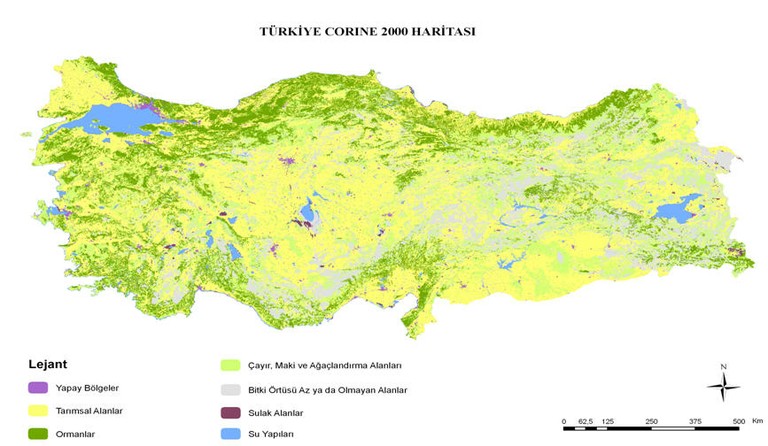Published: 26 Nov 2010
Modified: 17 Feb 2025
Structural pressures exist regarding land use in Turkey. The
various kinds of land, and especially arable land, can have problems of varying
types and dimensions resulting from the different sorts of soil. 14.2 % of
Turkey’s soil is deeper than 90 cm while the remaining 85.8 % is divided into
11.9 % moderately deep (50‑90 cm), 30.5 % shallow (20 50 cm) and
37.2 % very shallow (<20 cm) land. It is indeed a disadvantage for Turkey’s
agriculture that shallow soil constitutes a large share that constrains the
type and amount of production. .
Turkey is one of the countries subject to a high degree of
erosion due to its topographical structure, climate, the incorrect agricultural
methods used, the excess pasture and forest destruction and the fact that most
land is prone to erosion. In addition, the slope conditions make agricultural
processes difficult and facilitate erosion which also pose a significant land problem
in Turkey.
The rapid population increase and industrialisation has
increased rural to urban migration and led to the establishment of settlement areas
replacing productive agricultural land in certain regions. The small areas of
land in agricultural enterprises cause the producers to use non-productive fields
(grassland-pasture, forest) for agricultural production. Tourism investments
that are not sensitive to the environment may cause irreversible damage in
coastal and forest areas. Human activity that has negative impacts on wetlands causes
the degradation of ecosystems.
The maps that show Corine Land Cover (CLC) 2000, 2006
and the change between 2000 and 2006 can be found below.

Map 1: MAP OF LAND USE IN TURKEY IN 2000
|
TÜRKİYE
CORINE 2000 HARİTASI
|
TURKEY CORINE 2000 MAP
|
|
Lejant
|
Legend
|
|
Yapay
Bölgeler
|
Artificial
areas
|
|
Tarımsal
Alanlar
|
Agricultural
areas
|
|
Ormanlar
|
Forests
|
|
Çayır,
Maki ve Ağaçlandırma Alanları
|
Grassland,
scrub and forestation areas
|
|
Bitki
Örtüsü Az ya da Olmayan Alanlar
|
Areas with
no or little vegetation
|
|
Sulak
Alanlar
|
Wetlands
|
|
Su
Yapıları
|
Water
bodies
|

Map 2: MAP OF LAND USE IN TURKEY FOR 2006
|
TÜRKİYE
CORINE 2006 HARİTASI
|
TURKEY CORINE 2006 MAP
|
|
Lejant
|
Legend
|
|
Yapay
Bölgeler
|
Artificial
areas
|
|
Tarımsal
Alanlar
|
Agricultural
areas
|
|
Ormanlar
|
Forests
|
|
Çayır,
Maki ve Ağaçlandırma Alanları
|
Grassland,
scrub and forestation areas
|
|
Bitki
Örtüsü Az ya da Olmayan Alanlar
|
Areas with
no or little vegetation
|
|
Sulak
Alanlar
|
Wetlands
|
|
Su
Yapıları
|
Water
bodies
|

Map 3: MAP OF LAND USE CHANGE IN TURKEY BETWEEN 2000 AND 2006
The change in land cover between 2000 and 2006 shows
an increase in settlement areas and water bodies, and a decrease in agricultural
use, forests and semi-natural vegetation and wetland. When we evaluate the direction
of change, approximately 25 952 ha forest areas, 13 451 ha agricultural
land, and 1 515 ha wetland within the country's surface area have changed
to classification types other than their sub‑use classifications and are now
being used in ways other than intended. According to the settlement indicators,
the highest overall change in the county is the increase in artificial areas
with a size of 37 729 ha. The five provinces with the largest increase are
presented in Graph 3.

|
GRAFİK 3:
YAPAY BÖLGELERİN ARTIŞ GRAFİĞİ
|
GRAPH 3:
GRAPH OF INCREASE IN ARTIFICIAL AREAS
|
|
Artış
Miktarı (ha)
|
Amount of
increase (ha)
|
|
Yapay
Bölgeler
|
Artificial
areas
|
|
Ankara
|
Ankara
|
|
İstanbul
|
İstanbul
|
|
İzmir
|
İzmir
|
|
Bursa
|
Bursa
|
|
Kayseri
|
Kayseri
|
|
İl Adı
|
Province name
|
The water bodies that were observed to increase by approximately
4 141 ha in size include dams and small lakes. A large part of this
increase consists of recently constructed dams.
When the overall use of ecologically important wet
areas is evaluated, an average of 1 500 ha has been opened to use in non-intentional
ways. Seasonal changes were not taken into account in these areas where the six
years of change was determined.
The study has also detected changes that might destroy
the forest ecosystem although the main source of the observed changes in forest
areas, national treasures and natural assets, can be interpreted as dynamism of
the country's forests in general.
Document Actions
Share with others